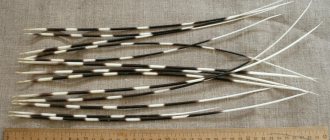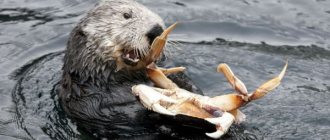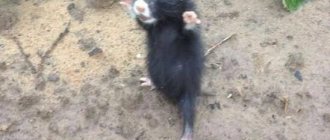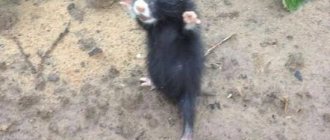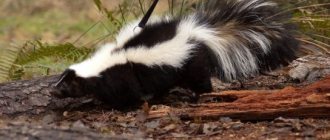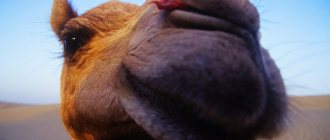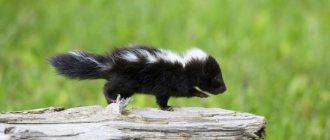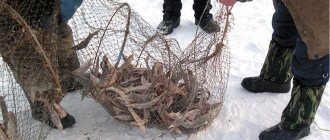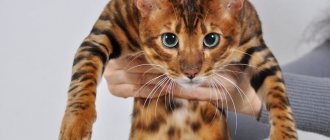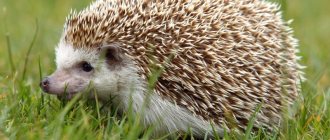- Skunk Smell
Which animal is the most feared by the rest of the animal kingdom? No, not a lion, not
a bear, not a tiger, and not any other even the most ferocious and formidable predator, but our today's hero - a skunk. Even very hungry predators avoid it, due, of course, to the famous skunk smell, so unbearable that it scares away almost everyone.
Description, structure, characteristics
The skunk belongs to the mammals of the order of carnivores, and until recently zoologists classified it as a member of the mustelidae family, but have now reconsidered their opinion. Skunks are now believed to form their own family, the skunk family.
You can easily recognize a skunk by its “signature” coloring, which consists of white stripes and/or spots on a black background. Skunks have a very strong build, a bushy tail and short legs with sharp claws, excellent for digging.
Skunks have poor eyesight, but this deficiency is more than compensated by their excellent sense of smell and hearing.
The largest of the skunk family, pig-nosed skunks, weigh up to 4.5 kg, the smallest, spotted skunks, weigh no more than 1 kg.
In general, the appearance of the skunk is very attractive, some people even domesticate skunks after first solving the problem with their smell; we will write about this in more detail below.
Smell
The more than unpleasant smell of these animals is perhaps their main characteristic feature. The source of the unpleasant odor of a skunk is special odorous anal glands that secrete a caustic substance that actually has such a specific aroma. Moreover, a scented stream of secretion can be sprayed by a skunk at a distance of 1-6 m.
In fact, the smell serves the skunk as an unusual defense against predators, and also a very effective defense. When in danger, skunks do not try to hide from their enemies, but instead raise their fluffy tail and stomp their paws on the ground threateningly. If the warning fails, then the skunk turns its back and shoots its foul-smelling, oily liquid at the enemy. To describe what the smell of a skunk is like, perhaps there are not enough verbal epithets. As a result, many predators, knowing about such a specific method of protecting the skunk, prefer not to mess with it at all and stay away from it.
An interesting fact: the smell of skunk secretion is so persistent that if it gets on, for example, human clothing, it is better to burn it immediately, since all means to clean the clothes after this can only mask the unpleasant odor, but will not remove it completely.
Great opportunist
Skunks are extremely adaptable and thrive in a wide variety of habitats as long as food and shelter are available. Because skunks rarely travel more than 3 km from their established dens, they choose sites located within 3 km of a water source.
Photo: www.animals.sandiegozoo.org
Dens are made in hollow trees, hollowed out logs, bushes, abandoned animal holes, as well as under porches and other structures. Skunks sometimes dig burrows underground if there are no other shelter options.
Nutrition
Skunks themselves are omnivorous predators and, as a result, their main food is various small rodents,
frogs, lizards. They do not disdain carrion, and since they are omnivorous animals, in addition to meat they can feast on grass, leaves, various fruits, and nuts.
Skunks often go out hunting at night, and to successfully overtake prey they use their well-developed senses of smell and hearing. They ambush small rodents, waiting for them, and when they appear, they make a swift jump, grabbing the prey with their paws and teeth.
Skunks also love honey very much, and when they come across
bee hive, then they will certainly ruin it. Bee stings are not scary for them due to their thick fur, through which a bee sting is not able to penetrate.
What does a skunk eat?
Photo: Striped skunk
Skunks, without a doubt, can be called omnivores; their menu includes both animal food and a variety of vegetation. Do not forget that animals are predatory.
Skunks enjoy snacking on:
- proteins;
- young rabbits;
- shrews;
- mice;
- snakes;
- some types of fish;
- crustaceans;
- lizards;
- worms;
- grasshoppers;
- larvae of various insects;
- eggs of birds and their chicks.
The animals will happily dine on a variety of vegetables and fruits, grains, foliage, herbaceous plants, and nuts. Skunks do not disdain carrion. As mentioned, skunks that live in human settlements eat food scraps in landfills and garbage cans.
Skunks go hunting at dusk, using their sensitive hearing and keen sense of smell. Having spotted their prey, for example, a lizard, they dig the ground, move apart stones, and disturb fallen leaves with their noses in order to get to the prey. Skunks grab rodents with their teeth, all this is done while jumping. If the caught victim has too rough skin or has thorns, then the cunning animals first roll it on the ground. It has been noted that skunks living in captivity are twice as large as their wild counterparts, because... their diet is richer in fat.
Interesting fact: Skunks have a sweet tooth, they simply love honey, eating it directly from honeycombs and bees.
Lifestyle
Skunks live in small families or alone, and their lifestyle is largely determined by natural rhythms. Skunks do not hibernate for the winter like bears, but, nevertheless, they spend the winter in their burrows, which they either dig themselves or capture from other animals. Also, during the summer and autumn, they try to accumulate as large reserves of subcutaneous fat as possible for the winter, with which it is much easier to get through the winter cold. With the onset of spring, skunks come out of their holes and become more active.
What kind of reputation have you earned?
The animal has a powerful reputation, although the animal itself is tiny. Unlike other predators, skunks do not pose a threat to human life. The natural behavior of the animal is characterized as playful. Skunks can teach a person to respect themselves from a position of reputation and strength. In the process of aura contact, feelings can be transmitted. If self-awareness is intact, then no harm will be caused to other people. Just like a person’s, an animal’s aura broadcasts its emotions and feeds on them. The indicator of self-esteem is reflected in the behavior of other individuals.
If the totem is a skunk, then the person will learn to draw inspiration from the world around him, attract and reflect energy, as “energy vampires” do. Over time, an understanding will come of how to properly use the energy flows that surround us. But it is not recommended to direct sexual energy towards someone unless the person is looking for a short-term relationship. Moreover, energy can be used in more constructive ways. Skunk will explain the principle of energy flows. The resulting power must be used wisely and only for good. By helping, a person will create a reputation for himself, and by spending the balance in vain, he will disgrace himself and remain misunderstood.
The opposite of the generally accepted standard
It is worth noting that excessive self-esteem may appear to be another act of faux pas or something dishonest. Other people may refuse your company and be afraid of jealousy or envy.
Rely on your feelings. You shouldn't lie to yourself. The simpler you approach life, the less strength you will lose. It may be better to remain silent than to start a protracted debate. Each person will evaluate such behavior differently. Energy consumption must be reduced as much as possible. It should not be wasted where it is not needed.
Enemies in nature
Thanks to such an amazing “aromatic” defense, the skunk has practically no enemies in natural conditions; it happens that they can be attacked by young predators:
foxes, coyotes, cougars, but solely due to inexperience, being still unfamiliar with “skunk scents”. Some birds of prey can also hunt skunks, such as the great eagle owl, which lives in the United States, but only because of its weak sense of smell, the eagle owl simply does not perceive the protective smell of a skunk or perceives it, but not as strongly as other animals.
Types, photos and names
striped skunk
The most common representative of the skunk family. It lives in North America from Canada to Mexico, often settling in forests.
Mexican skunk
The Mexican skunk is a close relative of the striped skunk, and it looks similar to it, except for the presence of softer and longer hair. It also has long hair on its head, which is why it is also called the hooded skunk. It lives in Mexico and some southern US states: Arizona, Texas.
Eastern spotted skunk
The smallest representative of the skunk family. Although, despite its small size, this skunk is not inferior to its larger counterparts in its ability to release foul odors. Also characteristic of it is its color - its fur is covered with white torn stripes, creating the illusion of spotting (hence the name of the species). Lives in both Americas.
South American skunk
The South American skunk lives in many countries in South America: Peru, Bolivia, Paraguay, Argentina, Chile. Its appearance and habits are in many ways similar to the striped skunk.
stinky badger
At first, scientific zoologists classified the stinking badger as a member of the mustelidae family, but later, thanks to the odorous properties of these animals, they were included in the kingdom of skunks. Unlike its stinky counterparts living in the New World, the stinking badger lives on the islands of Indonesia. In appearance they are similar to ordinary badgers, but in their habits and method of protection from predators they are the spitting image of a skunk.
Range, habitats
Numerous representatives of the family of mammals and the order of predators live in almost all territories of the New World. Animals from the genus Striped skunks have spread from southern Canada to Costa Rica, and the genus Hog-nosed skunks inhabit areas from southern America to Argentina.
Representatives of the Spotted Skunk genus can be found from the southernmost lands of British Columbia and Pennsylvania all the way to Costa Rica. Stink badgers, classified as skunks, are two species that live outside the Americas and are also often found on the island lands of Indonesia.
Return to content
Reproduction
Skunks are polygamous animals; one male, as a rule, has sexual intercourse with several females, thus creating a small animal harem. The mating season for skunks begins in early spring, and by mid-summer, after a short pregnancy, females give birth to cubs. Usually, on average, one skunk mother gives birth to 6 to 10 babies. Little skunks, like kittens, are born blind and only after a week their eyes begin to open. At first they are completely helpless and are completely dependent on their mother, who feeds them milk. Then the babies begin to quickly grow and get stronger, and by four months they already pose a serious “odorous” danger to others.
Kinkajou lifestyle
The kinkajou is an exclusively arboreal animal. Since the animals always stay high in the treetops, they extremely rarely become victims of terrestrial predators, in particular the jaguar. For birds of prey that hunt during the daytime, the animal is inaccessible, since during the day it hides in hollows. For non-tropical owls, the honey bear is too large a prey item. So the animal is lucky - in nature it has practically no enemies. He comes down to the ground extremely rarely, and his arboreal lifestyle provides him with complete safety.
The animal finds an abundance of food in the treetops. 90% of its diet consists of fruits, and it prefers the ripest and sweetest fruits. In some parts of their habitat, kinkajou diversify their diet with insects - ants, termites, etc. But the animal has a special passion for flower nectar and honey. He obtains these goodies with the help of a very long tongue.
In the photo, the kinkajou shows off its long, narrow tongue.
On the chin, throat and chest, the kinkajou has glands that produce an odorous secretion. With their help, animals mark the boundaries of their territory, which can reach 30-50 hectares.
Most often, honey bears feed alone, but if food is abundant, they can also feed in groups.
Typically, animals, like most representatives of the order of carnivores, feed at night, and from sunrise to sunset they rest in their shelters - tree hollows or among palm leaves. In extreme heat, sometimes they simply lie on the branches, and up to five individuals can gather in one place.
Family matters
The social group of animals consists of a breeding female, her cub under the age of 1 year, two adult males, as well as older offspring (up to three years of age). This social structure is quite unusual among mammals. As a rule, males get along well together, but sometimes during the mating season they can show aggression. One of the males is usually dominant and the female will belong to him.
It is surprising that there are always exactly two males in the group. Perhaps this is due to the fact that one individual simply cannot cope with protecting the territory. It is difficult to single-handedly cover with odorous marks a large area that includes a group of females; moreover, the area may partially overlap with the area of at least one single male.
Females usually leave the family at the age of about three years. Inheritance of social status in groups occurs through the male line and territory passes from father to sons.
Within groups, animals demonstrate social behavior: they constantly sort through their fur, groom each other, play with their young, etc.
Some kinkajous live alone in their own individual territory, which may overlap with the habitat of group males.
These animals have a very low reproduction rate - females give birth to only one baby no more than once a year. Pregnancy lasts 112-118 days. For approximately 2 months, the baby feeds on milk and moves on the mother’s back, and then gradually begins to get used to living independently. In males, sexual maturity occurs at 1.5 years, in females - at 2.5 years.
Kinkajou can also be kept at home; in Mexico, for example, they are often kept as pets. In Russia, even for zoos, these small relatives of raccoons are a rarity.
The lifespan of a kinkajou in nature is on average 24 years, in captivity – up to 32 years. In contact with
Keeping at home
Recently, among lovers of strange pets, there has been a fashion for keeping pet skunks. And why not, because in appearance they are quite pleasant and cute animals. But what about the smell? A solution has been found: domestic skunks simply have their anal glands that emit their “signature” odor removed, and the skunk becomes completely harmless in this regard.
Regarding the care and nutrition of the domestic skunk, it is in many ways similar to those of dogs. That is, skunks can be fed the same food that you feed your pet dog.
Video
And in conclusion, an interesting video about a man meeting with a real, smelly skunk.
Author: Pavel Chaika, editor-in-chief of Poznavaika magazine
When writing the article, I tried to make it as interesting, useful and high-quality as possible. I would be grateful for any feedback and constructive criticism in the form of comments on the article. You can also write your wish/question/suggestion to my email [email protected] or Facebook, with respect, the author.
Author page
This article is available in English -
Skunks.
